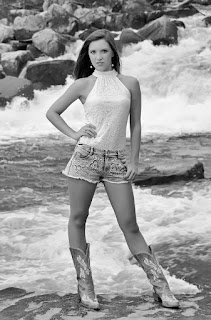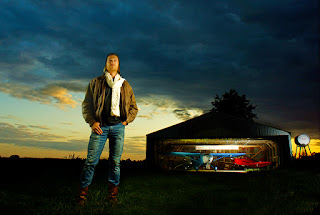 On one of my first model location shoots I showed up at the location not having a clue of what I was going to do photographically. "I'll just wing it..." I told myself. The results were, well...predictable. The images looked rather ordinary and snapshotish at best. Winging it can at times produce some wonderful results, but that usually happens only after you apply lessons learned from previous shoots using a game plan. As I continued to develop my location shooting skills it became apparent how having a game plan of what I wanted to accomplish was an important element to help me focus my efforts on a particular theme.
On one of my first model location shoots I showed up at the location not having a clue of what I was going to do photographically. "I'll just wing it..." I told myself. The results were, well...predictable. The images looked rather ordinary and snapshotish at best. Winging it can at times produce some wonderful results, but that usually happens only after you apply lessons learned from previous shoots using a game plan. As I continued to develop my location shooting skills it became apparent how having a game plan of what I wanted to accomplish was an important element to help me focus my efforts on a particular theme.A good photographer friend of mine seems to do this naturally without effort. At times it appears he is winging it, and maybe there is an element of that in his technique, but his approach is one of mentally breaking down the shoot into manageable photographic steps, tweaking the moment just enough until what he is visualizing suddenly appears in front of him and then he captures it. He has a knack for identifying the artistic elements of what is truly there and then being able to bring the moment to life. I've learned a great deal simply observing him as he works.
Shooting with a game plan involves several things. First of all, you must have an instinctive command of your equipment. Being able to know how your camera is going to react to a given lighting situation is key as it gives you the ability to make exposure adjustments on the fly without too much thinking about it. Understanding exposure in general is a must. Always shooting on program mode handicaps your ability to use creative instincts. Also, understanding exposure using artificial lighting...speedlights...is without a doubt one of the most important elements of your game plan. Speedlights give you the ability to control different planes of light at the same time. Understanding how to apply this gives you a powerful advantage. Also, test your equipment. I once did a shoot that required several speedlights where three of them were placed some distance from the camera transmitter. Turned out the transmitter would not reach that far and I struggled to get the shot, initially. However understanding how the lights worked, I was able shift them from being fired directly to being fired as slave units trigger by the flash of another another unit which solved my problem. So understanding your equipment and its limitations is an important aspect of implementing a game plan.
Secondly, having a game plan gives you a place to start. You know from the beginning what you want to accomplish even though the steps to get there may not be readily apparent. Every shoot is different in their dynamics. The lighting is different, the setting, the model, the angles, the energy, in short you the photographer must be able to adapt to your surroundings. Your game plan provides you with an idea, a direction in which to travel. It becomes your shooting roadmap without which it might become easy to get lost or sidetracked. Also, remember the best laid plans do not always go according to the plan, so be willing to adjust your game plan. Even though some of my most successful photographs are the result of having a plan in place, the idea did not always fit the actual live situation.
Thirdly, your game plan should include knowing the location. Ask yourself a few questions. What direction will the light be coming from at any given time of day? Are there shaded areas or high contrast areas? Are there background distractions? Will I need overcast skies or sunny skies? Will this be better late or early in the day? How easy is it to setup...is there a hike involved and if so how do I get my equipment in there? What equipment will I need? What is the most dramatic angle? And, most importantly, what am I trying to accomplish...what will my finished photograph become? I will spend a great deal of time simply searching for locations and then make mental and sometimes physical notes about the location and how it might be used in a shoot. One thing to keep in mind, a game plan will work regardless of the purpose be it a high school senior location shoot, a wedding, or a shoot focused on capturing a single specific type of look or photograph.
Shooting with a game plan helps you to become more efficient in the field. During many of my earliest attempts of shooting a model on location I struggled to find a focused effort and wasted a lot of time. In reality I did not know what I was doing and jumped around trying this and that and ended up with photographs that looked like this and that. During the times I have observed my friend during his shoots, it became apparent at just how efficient he was. Move here, move there, this angle, this lens, this light. He seemed so in command of what he was doing. It is a trait I wish to emulate. Many times I tend to attach a lens and stay with it throughout the shoot when I should have changed lenses a time or two to obtain a different look. Be willing to make strategic changes during your shoot if for no other reason just to see what happens. You can always go back to what you were doing.
A game plan can apply to other types of shooting. Take for instance this photo of a beautifully restored 1976 Corvette in front of the National Corvette Museum. Having a plan in place, knowing the location, using speedlights, then adapting to the situation allowed for a really fun shoot of an iconic car and location.
Lastly, stay within your style of shooting, but experiment with new techniques and styles. Avoid growing stale by not doing the same ole thing the same ole way all the time. All of us can learn from others, but all of us tend to migrate toward a comfortable style. It is perfectly normal to do so, but do not be afraid to try something new...step out on the edge every now and then and spread your photographic wings. That is the only way you will grow.
























